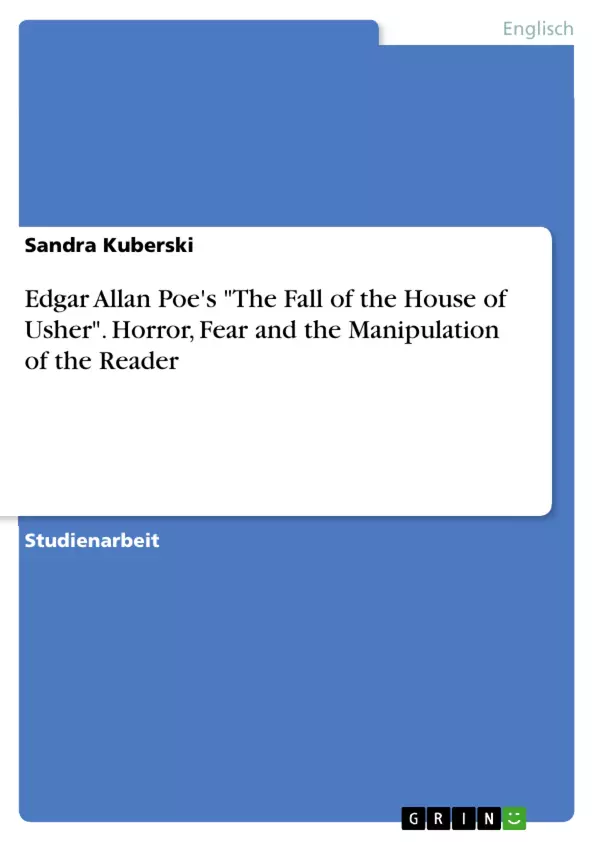Edgar Allan Poe is one of the most famous American authors; however, he is “the most controversial” . Not only his works fueled the debate on him, but also his almost scandalous biography, which includes alcohol, drugs, financial problems, a marriage with his only 13-year-old cousin and a strange personality, that gave him a reputation of a grumpy, even violent person. Nevertheless he had a great influence on American literature and the modern short story.
The attention of this essay will be focused on Poe's means and methods of manipulating the reader with the effect of horror and fear. This shall be demonstrated on the example of “The Fall of the House of Usher”. The story was written in spring or summer of 1839 in Philadelphia. It was published in September of that year in Burton’s Gentleman’s Magazine, of which Poe was assistant editor. A collection of 25 stories named “Tales of the Grotesque and Arabesque”, including Usher, came out in December. Thomas Woodson describes Usher as “Succession of futile efforts to establish himself, to define a solid identity for posterity, for his contemporaries, and for himself. It is of course typical for him that he should try to construct his own literary personality by dramatizing the fall of a house and of a family.”
Inhaltsverzeichnis
- Introduction
- Unity of Effect
- The Formation of Atmosphere
- Effects of Fear and Decay
- Roderick Usher and his Family
- Change of the narrator
- Influence on the Reader
- Conclusion
Zielsetzung und Themenschwerpunkte
Diese Hausarbeit analysiert Edgar Allan Poes "The Fall of the House of Usher" und untersucht, wie Poe den Leser mit Horror und Angst manipuliert. Die Arbeit konzentriert sich auf die Gestaltung der Atmosphäre, die Darstellung der Familie Usher und die Rolle des Erzählers, um zu zeigen, wie Poe seine Leser in die Geschichte einbezieht und sie emotional beeinflusst.
- Die Rolle von Atmosphäre und Umgebung in der Schaffung von Horror und Angst
- Die Beziehung zwischen dem Verfall des Hauses Usher und dem Verfall der Familie
- Die Manipulation des Lesers durch Poe's Erzähltechniken und den Einsatz von Symbolen
- Die psychologischen Auswirkungen des Horrors auf den Erzähler und den Leser
Zusammenfassung der Kapitel
Introduction
Die Einleitung stellt Edgar Allan Poe als einen der berühmtesten amerikanischen Autoren vor, dessen Werke und Biografie gleichermaßen kontrovers sind. Die Einleitung beleuchtet Poes Einfluss auf die amerikanische Literatur und die Entwicklung der modernen Kurzgeschichte.
Unity of Effect
Dieser Abschnitt analysiert Poes Theorie der "unity of effect", die besagt, dass Literatur auf ihre Wirkung hin betrachtet werden soll. Poe strebte danach, die Leser emotional zu bewegen und ihnen eine zentrale Idee durch den Einsatz von Atmosphäre, Charakterisierung und Sprache zu vermitteln.
The Formation of Atmosphere
Dieses Kapitel untersucht die Bedeutung der Atmosphäre in "The Fall of the House of Usher". Poe verwendet detaillierte Beschreibungen des Hauses und seiner Umgebung, um eine Atmosphäre des Verfalls und des Horrors zu schaffen, die sowohl die Charaktere als auch den Leser beeinflusst.
Schlüsselwörter
Die wichtigsten Schlüsselwörter dieser Arbeit sind: Edgar Allan Poe, "The Fall of the House of Usher", Horror, Angst, Atmosphäre, Erzähltechniken, Familie Usher, Verfall, Symbolismus, Lesermanipulation, Einheit der Wirkung, Gothic, Psychologische Effekte, Erzählerperspektive.
- Arbeit zitieren
- Sandra Kuberski (Autor:in), 2011, Edgar Allan Poe's "The Fall of the House of Usher". Horror, Fear and the Manipulation of the Reader, München, GRIN Verlag, https://www.grin.com/document/275431



